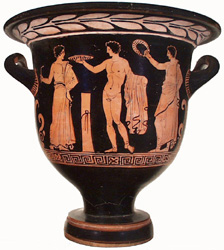 The red-figure technique for figure and subsidiary decoration on vases involves the painting of outline, with linear detail, and the background filled with black. It is thus like a reverse of black figure with detail executed by a brush rather than a graver, which gave the artist more freedom for the new, realistic style he sought to express. It was invented in Athens about 525 BC, perhaps inspired by other arts in which figures are set against a dark background. Preliminary work could involve rough sketches, perhaps in charcoal, which just bruise the surface of the vase, and a broad band outlining the figures. There is seldom much added colour but from the end of the 5th century onwards white is used quite frequently and even gilding. A relief line is used on the earlier vases, and varying thicknesses of paint lent an illusion of texture. The technique disappears before the end of the 4th century BC.
The red-figure technique for figure and subsidiary decoration on vases involves the painting of outline, with linear detail, and the background filled with black. It is thus like a reverse of black figure with detail executed by a brush rather than a graver, which gave the artist more freedom for the new, realistic style he sought to express. It was invented in Athens about 525 BC, perhaps inspired by other arts in which figures are set against a dark background. Preliminary work could involve rough sketches, perhaps in charcoal, which just bruise the surface of the vase, and a broad band outlining the figures. There is seldom much added colour but from the end of the 5th century onwards white is used quite frequently and even gilding. A relief line is used on the earlier vases, and varying thicknesses of paint lent an illusion of texture. The technique disappears before the end of the 4th century BC.
Above: Typical example; Apulian red-figure bell-crater. Ashmolean Museum 1944.15. Photo. Beazley Archive. © Beazley Archive, Ian Hiley